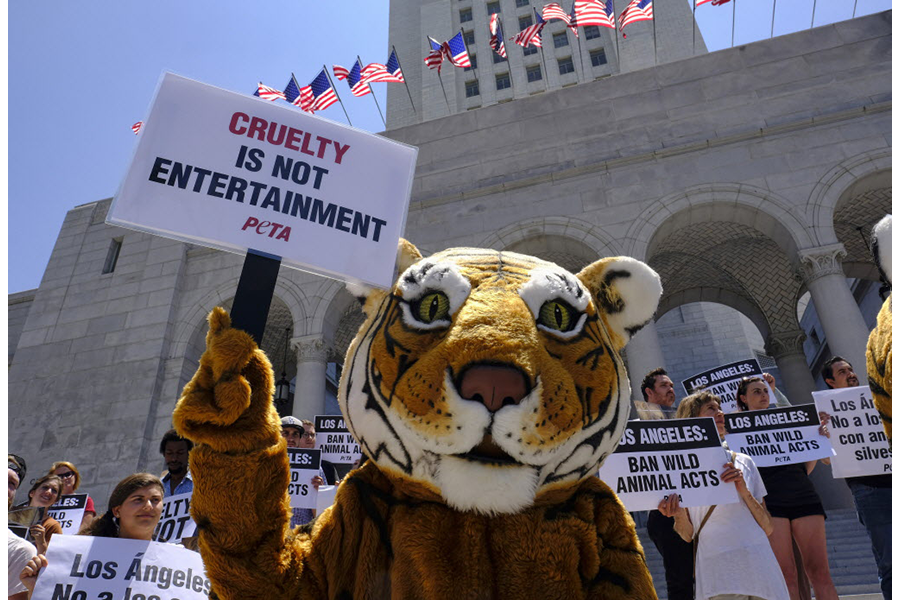Dublin bans animal acts from circuses. Part of a broader shift?
Loading...
Wild animals will no longer perform circus tricks in Dublin, Ireland.
The Dublin City Council voted to ban the use of animals in circus acts last week, marking the latest victory for animal rights activists.
"The tide is turning, and we welcome the day Irish circuses can thrive with proper artists and acrobats. That way everyone can have fun," John Carmody of Ireland's Animal Rights Action Network told Dublin Live.
Dublin isn't alone in taking this step. Mexico's ban of wild animals in circuses went into effect last year and many other countries have full or partial bans.
"What is wrong with using animals in circuses?" Mr. Carmody asked. "With the very best intentions in the world, a travelling circus is unable to adequately provide for the animals in their care."
Jeff Kinzley, elephant manager at the Oakland Zoo, told The New York Times in 2015 that animals shouldn't be used in circuses or traveling shows because travel itself is a problem. The stress of travel "is pretty phenomenal, and you put in there the type of training that is used, pretty heavy-handed physical discipline, and the strain that goes along with that," he said.
In the United States, circus animals are quietly retiring, too. In May, the elephants that have been the face of the Ringling Bros. and Barnum & Bailey Circus for about two centuries performed their final show.
The circus company had decided to phase out the elephant act in response to consumer and economic pressures.
"There's been somewhat of a mood shift among our consumers," said Alana Feld, the executive vice president of parent company Feld Enterprises Inc., reported the Associated Press last year. "A lot of people aren't comfortable with us touring with our elephants."
But Kenneth Feld, company president, insisted, "We're not reacting to our critics; we're creating the greatest resource for the preservation of the Asian elephant."
The working elephants joined animals that had already retired to the company's 200-acre Center for Elephant Conservation in central Florida.
But Mr. Feld did acknowledge the economic pressures of legislation against circus animals in cities and counties across the country that made it more difficult and more expensive to organize tours for the three traveling circuses under the Feld Enterprises umbrella. "All of the resources used to fight these things can [now] be put toward the elephants," he said.
Circuses aren't the only spectacles changing their practices in response to animal rights activists. In March, SeaWorld ended its killer whale breeding program. As they had long since pledged not to collect orcas from the wild, that meant the whole program will be phased out within a decade or two.
SeaWorld's announcement came amid growing criticism of the way the captive marine animals were treated, which was fueled by the release of the 2013 documentary "Blackfish."
"The announcement today is the humane economy at work, where businesses … realize that doing right by animals is going to eliminate risk and provide economic opportunity," Wayne Pacelle, executive director of the Humane Society of the United States (HSUS), a former critic that has partnered with SeaWorld in the theme park’s new initiative, told The Christian Science Monitor in March.
"At the root of it is an emerging consciousness among consumers/voters," he added. "They’re demanding more from decision-makers and wanting companies to do better on animal welfare."
Part of the pressure comes from an increased understanding of animal cognition, says Barbara King, anthropology professor at William & Mary in Williamsburg, Va., and author of "How Animals Grieve."
"There is a sea change going on in our culture about animals, and we are coming to recognize the profound depth of animal emotion and thinking and suffering," Dr. King told the Monitor in March 2015. "This research is beginning to trickle down into the public awareness and driving public outcry."
Ironically, researchers have learned this from caged animals, Sarah Cunningham, a professor in the Captive Wildlife Care and Education program at Unity College in Maine, told the Monitor.
"Part of the reason [societal attitudes] are changing is because we’ve learned so much about the cognitive abilities and social lives of other species from individuals that we work with and study in captivity," she said.
Keeping animals in captivity can be good for the public, argued blogger James Norton in a 2013 article for the Monitor.
"Book and Web searches are fine and dandy, but to really gain an appreciation for the miracle of biology that is an elephant, or octopus, or ostrich, it really helps to see one in the flesh," he wrote. "There are far worse ways to stimulate young minds than putting them in close proximity to an alien life-form, and letting them sort out all the differences between animals and people – and all the shared ground, too."






